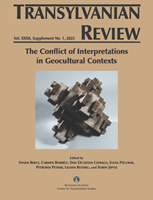What Language Did the Moldavian Romanians in Tsarist Bessarabia Speak?
What Language Did the Moldavian Romanians in Tsarist Bessarabia Speak?
Author(s): Ion EremiaSubject(s): Cultural history, Social history, Historical Linguistics, 19th Century
Published by: Academia Română – Centrul de Studii Transilvane
Keywords: Romanian language; “Moldavian language;” Wallachia; Romanian countries; Bessarabia; Transylvania;
Summary/Abstract: The cited sources clearly show that until the 7th decade of the 19th century, the priests in the Bessarabian churches used religious books printed in Romanian in the cities of Wallachia and Transylvania, although several authors of the 19th century wrote that they were printed in the “Moldavian language.” This state of affairs, in its turn, attests to the fact that the authors of the 19th century acknowledged the identity of the Romanian language and the “Moldavian language.” In other words, the Romanian language used by the priests in the Romanian Orthodox Church in the three Romanian countries was the same, the church language was one and the same in Bucharest and Râmnic (Wallachia), Blaj and Sibiu (Transylvania), and in the Bessarabian villages of Saharna, Abacladjaba, Susleni, Batâr, etc. The use in Bessarabia of church books printed in Wallachia and Transylvania refutes the myth of the existence of a “Moldavian language” different from the Romanian language used in Wallachia and Transylvania. On the contrary, it proves the unity of the Romanian language listened to by believers in the church in all localities inhabited by Romanians—it was a single Romanian liturgical language that Romanian believers in Wallachia and Transylvania, in Moldavia between the Prut and the Carpathians, and in Bessarabia listened to and spoke.
Journal: Transylvanian Review
- Issue Year: XXXII/2023
- Issue No: Suppl. 1
- Page Range: 69-79
- Page Count: 11
- Language: English

